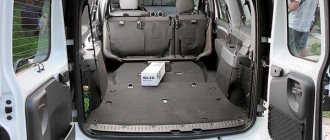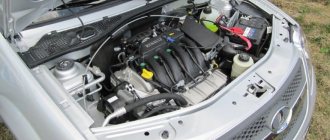Lada Largus Van is an ideal solution for business and light commercial transportation. The van based on the Lada Largus station wagon began its history back in 2012 in the city of Tolyatti. Initially, the Dacia Logan MCV station wagon of the 2006 model year was taken as a basis.
In 2021, the LADA LARGUS Van received a facelift and became known as the LADA Largus Furgon FL. We talked about all the changes in one of our posts.
What is the carrying capacity of the Lada-Largus: comparison with competitors
The certified carrying capacity of all modifications of the Lada Largus, calculated as the difference between the curb and gross weights of the vehicle, has the following values:
- 445 kg for a 5-seater station wagon;
- 480 kg for the 7-seater version and for Largus Cross;
- 750 kg for a van.
Undoubtedly, the characteristics are impressive for a B-class family car, and the Largus van is comparable to the capabilities of representatives of the commercial LCV segment, such as the GAZ-2752 Sobol.
However, considering cargo capabilities only in terms of payload is not entirely correct. After all, humanity invented trucks to transport cinder blocks and floor slabs. And for a typical station wagon owner, the most important thing is to answer the question of whether he can carry ten packs of insulation at a time, and whether a two-meter refrigerator will fit into the cabin.
Therefore, it is possible to more objectively assess the cargo capabilities of the Lada Largus based on the volume of the luggage compartment and its dimensions (depth, width and height).
In addition, we should not forget about the price component: the Audi allroad station wagon with a three-liter engine has a comparable maximum load capacity of 500 kg, but the cost is equal to 8.5 Largus.
Characteristics of K7M
These power units were successfully installed on the Renault Logan, Renault Sandero, and now on the Lada Largus. Until 2010, the K7M 7100 engine was successfully produced and operated. After modernization, it was replaced by the K7M 800, which had no structural differences, and the difference between them was in the number of horsepower, their number decreased (there were 86 “horses”, now - 83 ). Changes also affected environmental performance. The new engine belongs to the Euro-4 category.
However, the shortcomings have not gone away:
- Fuel consumption was still high;
- There is a problem with floating idle speed;
- Engine valves need to be adjusted almost every 20-30 thousand kilometers;
- There are no hydraulic compensators;
- It is recommended to change the timing belt every 60 thousand kilometers;
- After prolonged use, more than 70–90 thousand kilometers, crankshaft oil seals may leak;
- The engine is too noisy when running;
- During long-term operation at high speeds, vibration may occur in the engine.
If we consider the advantages of the engine, then among them the reliability of such power units stands out as a bright spot. According to the factory, the engine life is about four hundred thousand kilometers, although in real conditions it may be a little more.
Volume and dimensions of the luggage compartment of the Largus family
So, we present the contenders for the championship title in the category “The most spacious trunk for 500 thousand rubles”:
The 5-seater Lada Largus with a load capacity of up to 445 kg, according to official information from AvtoVAZ, has a luggage compartment with a volume of 560 liters. With the rear row seats folded down, 2,350 liters of usable space are available to accommodate cargo.
The linear dimensions of the compartment have the following values:
- Trunk length 90 cm or 174 cm (to the level of the backs of the front seats);
- Actual compartment width 134 cm;
- The height of the rear door opening is 92 cm.
In the 7-seater modification of the Lada Largus, the load capacity declared by the manufacturer is increased by 35 kg compared to its 5-seater brother due to the reinforced suspension. The trunk is designed for 135 liters of cargo. By folding the backrests of the third row of seats, you can increase the luggage volume to 560 liters. A maximum capacity of 2,350 liters is provided when all rows of seats except the first are folded down. The Lada Largus Cross also shows similar load capacity parameters.
The following video describes the procedure for dismantling the right-side seats for transporting cargo over two meters long:
Warning! Stowing cargo above the openings of the side and rear windows seriously impairs visibility. Be careful when driving so as not to get into an emergency situation.
Another unique modification of Largus is a van, suitable for transporting small quantities of various goods or for use as a traveling vehicle for repairmen, builders and other technical services.
The Largus cargo van has a load capacity of up to 750 kg. The length of the luggage compartment is 194 cm at floor level; at roof level the size is reduced due to the shape of the cabin partition. The floor distance between the rear wheel arches is 96 cm, the actual width of the cargo compartment is 134 cm. The width of the side door opening is about 61 cm.
Reminder! Unless absolutely necessary, you should not exceed the maximum load capacity established by the manufacturer, even if the luggage compartment space allows it. In this case, there is a high probability of damage to the vehicle’s suspension elements.
Cargo bay exterior
The car model, which was created in 2021, can first of all be compared with its station wagon brother, and the differences in body shape will be obvious:
- A rather practical solution in commercial terms is to paint the side mirrors and bumper of the car in black, and not in the main tone of the car, because when transporting cargo along country roads, there are often cases of dents and scratches that remain almost invisible against a dark background.
- The car is equipped with rear blind doors without glass. This design reduces the likelihood of damage to the surface of the transported cargo, even when driving on uneven roads.
Despite the large size of the cargo compartment of the Lada-Largus van, the car looks compact in appearance, which is a winning advantage.
Domestic B-class competitors
Among the products of the Russian automobile industry in the station wagon body are the Lada Priora and Lada Kalina 2 cars.
For the Lada Kalina 2 (VAZ 2194), the name “station wagon” rather informs about the body type than indicates serious load-carrying capacity. The luggage compartment capacity is 355 liters (with the rear row of seats folded - 670 liters), which is comparable to that of full-size sedans. Based on the dimensions of the Kalina platform, the linear dimensions of the luggage compartment are also very modest.
Let's sum it up
The owners today have gained considerable experience in using LADA Largus in various fields and industries. They all nod their heads contentedly when asked about the convenience and practicality of the trunk. On the Internet you will find only a limitless mass of positive reviews about this model.
The size of the trunk turned out to be sufficient for the car to effectively demonstrate its functionality and be able to take the lead from competitors “touching on their heels”. The manufacturer managed to competently and rationally arrange the body space, which allows the station wagon to effectively cope with large objects, demonstrating an enviable carrying capacity.
The Lada-Largus van gained great popularity back in 2012, when the car first entered the domestic market, literally immediately ranking with such well-known car brands as Citroen Berlingo, Renault Kangoo and VW Caddy. But it is worth noting that Lada-Largus is in a completely different price segment.
We have made sure that the practical station wagon LADA Largus in the domestic market space has an undeniable leadership in terms of capacity and carrying capacity. This car also has an enviable advantage over its competitors - its price, which in most cases can tip the scales in favor of the “hero” of our article.
Foreign cars with comparable carrying capacity
If it is difficult to find a car with similar characteristics among ordinary station wagons, you should turn to neighboring classes.
5 and 7-seater options with a spacious trunk are typical for the MPV class, which unites minivans and high-capacity station wagons. Among the typical representatives are Renault Kangoo, Peugeot Partner, Fiat Doblo, Skoda Roomster, Volkswagen Caddy.
Without focusing on the significantly higher cost of these vehicles, we will conduct a comparative analysis of their cargo capabilities:
- Renault Kangoo is available as a 5-seater minivan with a payload of 451 kg and a van with a payload of 592 kg. Luggage compartment volume ranges from 660 liters as standard to 1,524 liters for vans and minivans with the rear seats folded down.
- The Skoda Roomster is designed for 5 seats and can accommodate from 450 to 1555 liters of luggage weighing 455 kg.
- Peugeot Partner in minivan format (5 seats) with a luggage compartment of up to 2800 liters and in a van modification of up to 2830 liters can carry up to 600 kg of luggage.
- Volkswagen Caddy for 5 or 7 passengers takes up to 665 kg of cargo in the trunk. The volume of the compartment, depending on the configuration of the seats, ranges from 750 to 3300 liters. The Caddy Maxi van with an extended wheelbase has a luggage compartment volume of 4.2 m3.
Engine tuning
Many motorists want to make their engines better and more powerful. This is why the tuning and modification procedure is carried out. For engines such as the Lada Largus, there are two options for modification - mechanical and software tuning. But, most vehicle owners prefer to make a second modification.
Soldering the chip into the ECU
In order for everything to work out and not have to often stand in line to see an electrician-programmer, the ideal option is to install a chip in the engine control unit. After this, the software is installed, and subsequently the chip regulates the operation of all necessary systems.
How is the actual process of introducing a chip into the “brains” of a vehicle carried out? This procedure is quite difficult and requires advanced knowledge in radio electronics, as well as automotive electrical engineering. So, this process is best left to specialists.
The chip itself can be mounted (soldered) directly into the electronic engine control unit or at an intermediate stage, depending on the purpose of the equipment.
Recently, controllers and various chips that motorists install into their cars themselves have become popular. As practice shows, this does not always have a positive effect on the performance of automotive systems. Experts and auto electricians recommend that before installing anything in a vehicle, consult with professionals and weigh all the pros and cons.
Brain firmware
The second option is chipping the standard engine control unit. Motorists and craftsmen divide this type of tuning into three parts:
- Firmware to reduce fuel consumption.
- Firmware to increase power.
- Balanced firmware.
As practice shows, most owners of Largus engines use the option with reduced consumption. It is worth understanding that by reducing the flow rate, the dynamic characteristics are also reduced. Thus, power units may respond late to changes in the position of the accelerator pedal, which in turn does not have a very good effect when overtaking.
It is worth noting that the chipping procedure must be trusted to professionals. Only they will tell you what type of tuning is most suitable for the engine and will take into account the wishes of the motorist.
Station wagon, minivan and van - are there any differences inside the cars?
Many car enthusiasts know that the Lada Largus is available in three body styles: station wagon, minivan and van. The options do not have any special differences, except for one “but” - they have a different number of seats:
- The standard station wagon has 5 seats and a medium-sized trunk (560 liters).
- The extended station wagon, also known as a minivan, has 7 seats and a small trunk (170 liters).
- The van has only 2 seats - one for the driver, the other for the front passenger. This Largus variation has an extended trunk (about 2000 liters), which is needed for transporting large cargo.
Apart from the number of seats, there are no differences in the interior design of all variants of the Lada Largus. The general concept of the interior is determined based on the selected configuration:
- in cars with a budget set of options, the interior has an “economy class” character, featuring standard AvtoVAZ upholstery: fabric seat covers and a lot of plastic;
- in models with a more “advanced” set of options, the interior is necessarily complemented by leather upholstery of the steering wheel, seats and some parts of the interior upholstery; in addition, in the interior design you can find various multimedia additions and upgraded components of standard equipment.
Important! The general interior concept for all variations of the Lada Largus is the same. The final design format is determined not by the chosen body option, but by the specific configuration.
Engines and transmission
From the very beginning of production, the Largus F90 was equipped with two 1.6 liter gasoline engines from the French company Renault with the indices K7M (8-cl., 84 hp) and K4M (16-cl., 105 hp), but in Later, these engines were replaced by domestically produced engines. The K7M was replaced in 2015 by the eight-valve internal combustion engine VAZ-11189, and in 2017, instead of the K4M, the car received a sixteen-valve VAZ-21129. All Largus Van variants have a manual transmission (5 steps), provided by French developers; manual transmission models are JR5 and JH3.
The VAZ-11189 brand is an in-line four-cylinder engine with a volume of 1596 cc. cm , 8-valve, has the following data:
- max power - 87 hp. With. ;
- fuel system type - injector;
- torque max - 140 N*m ;
- timing drive - belt type;
- compression ratio - 10,5;
- compliance with environmental standards - Euro-5;
- Recommended fuel is AI-92 gasoline.
The engine of model 11189 allows Largus to accelerate to 158 km/h and reach a hundred in 15.4 seconds . Average fuel consumption per 100 km with an 8-valve VAZ engine, according to the automaker, is 8.2 liters , gasoline consumption in the city and on the highway is 10.6 and 6.7 liters , respectively.
The 21129 gasoline engine was launched into production in 2015 , originally intended for the Vesta and Xray car series. The engine has been installed on Largus since October 2017 ; it also meets the requirements of Euro-5 environmental standards. Characteristics of this internal combustion engine:
- volume - 1596 cubic meters. cm ;
- max power - 106 hp. With. ;
- torque max - 148 N*m ;
- valves per cylinder - 4;
- gas distribution mechanism drive - belt;
- compression ratio - 10,5;
- type of fuel system - injector.
Engine 21129 also easily “digests” 92-octane gasoline and provides the F90 van with acceleration to “hundreds” in 14 seconds , with a maximum speed of 165 km per hour . The fuel consumption of a utility vehicle per 100 km with a sixteen-valve VAZ engine in highway/city/average modes is 6.4/10.4/7.7 liters , respectively.
Rear cabin
Of course, the front part of the cabin of any car is more interesting to consider, since it is a kind of transport control center. Despite this, when studying the interior of the Lada Largus, it would be a crime to ignore a detailed examination of the rear of the cabin. To be fair, we note that there is something to see here too.
To begin with, let us remind you that in Largus the rear part of the cabin can be:
- or 5 armchairs (three and two of them are made as separate solid sofas);
- or 3 armchairs (made as a solid sofa);
- or a regular luggage compartment with a large capacity.
A pleasant difference between any organization of the rear part of the interior of the Lada Largus is that it is quite spacious. Moreover, any owner of this model, if desired, can remove the rear seats and personally turn his car into a van. Photos of the Lada Largus interior with 5 seats and 7 seats illustrating this concept are presented below.
The rear seats in Largus have comfortable head pillows for passengers, integrally built into the seat frame. There are standard seat belts on the sides of each seat. The rear doors are required to have armrests. In addition, the rear part of the cabin is filled with a considerable number of pockets, cup holders and similar containers for passengers’ belongings, which is simply good news.
The specific interior design in this area of the car is also determined based on the selected configuration of the Lada Largus and is similar to the front part (see photo below).
Important! The rear part of the cabin in Largus does not have any specific features, but it is made of very high quality and competently, which allows passengers to move comfortably in the car and behind it.
Ease of use
The practicality of the car is perfectly combined with a high level of comfort. The Lada-Largus van has a modern air conditioner and audio system, heated front seats, central locking, electric windows and other useful options that are a significant contribution to the profitability of the business. This is explained by the fact that driver comfort affects the success of transportation.
In addition to the above advantages, Lada-Largus has the following options:
- Power steering.
- The glove box is large.
- Pockets in the front doors for storing small items.
- The center console is ergonomic.
- A lighting point is integrated into the luggage compartment.
The car has high cross-country ability: ground clearance without load is 18.1 cm, with full load - 14.5 cm. The gear ratios in the gearbox are selected specifically for the cargo model.











